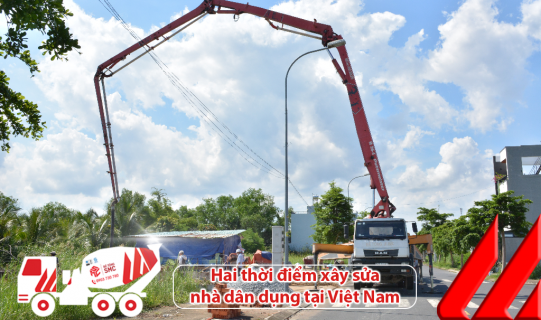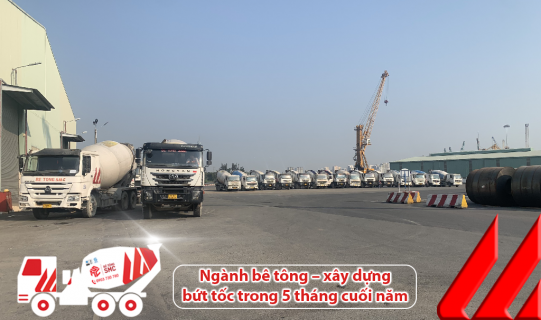Southern Vietnam's Ready-Mix Concrete Market: Strong Growth Amidst Supply Challenges
Over the past year, the construction industry in southern Vietnam has experienced significant developments, especially in the ready-mix concrete segment. Rising construction demand, material price fluctuations, and new design trends have created a vibrant yet challenging market landscape.1. Surging Demand for Ready-Mix Concrete
The recovery of the construction sector after the COVID-19 pandemic has driven demand for ready-mix concrete in the South. Major infrastructure projects such as expressways, bridges, and rapid industrial and urban development have significantly increased the need for high-quality concrete.According to reports from the Ministry of Construction, domestic cement consumption in 2024 is estimated to reach approximately 60–62 million tons, indicating a rising demand for construction materials, with ready-mix concrete accounting for a considerable share.
2. Seasonal Construction Trends: Residential and Industrial Sectors Lead the Market
2.1. Residential Construction: Stable Growth, Market Driver
The residential housing segment continues to play a leading role in the construction industry in southern Vietnam. Population growth, rapid urbanization, and rising living standards have strongly driven housing construction activity.Construction Industry Growth: Vietnam’s construction sector grew impressively by 7.8% to 8.2% in 2024—surpassing government targets and marking the highest growth rate since 2020.
Urbanization Rate: The urbanization rate reached 44.3%, exceeding the National Assembly’s target of 43.7%, highlighting the rapid expansion of urban areas and the corresponding demand for housing.
Peak Building Season: The first quarter of the year, especially January to March, is the peak period for residential construction, driven by favorable weather conditions and the tradition of starting fresh after the Lunar New Year.
2.2. Industrial Facilities: Robust Growth to Meet Production Needs
The industrial construction segment in the South has also seen strong growth in 2024, fueled by the need to expand production and attract foreign investment.High Occupancy Rates: The occupancy rate for ready-built factories in the South reached 89%, up nearly 8% from the previous year, showing strong leasing demand and rapid absorption of new supply.
New Construction Trends: Trends such as multi-story factories, the use of green materials, and modular designs that optimize space and reduce construction time are increasingly being adopted.
Construction Seasonality: The middle of the year—typically from April to September—is the peak construction period for industrial buildings, in preparation for increased year-end manufacturing activity.
3. Supply and Demand Imbalance: A Challenge for the Industry
Despite rising demand for ready-mix concrete, the cement industry—the primary input—faces a supply glut. According to the Ministry of Construction, Vietnam currently operates 92 cement production lines with a combined design capacity exceeding 122 million tons per year. In contrast, estimated consumption in 2024 is only around 95 million tons.This imbalance has led many cement companies to report losses, impacting the entire concrete supply chain. Additionally, prices of other raw materials such as sand and stone have fluctuated significantly, putting further pressure on production costs for ready-mix concrete.
Notably, in early 2025, several key national projects—including Long Thành International Airport, the Biên Hòa–Vũng Tàu expressway, and Ho Chi Minh City’s Ring Road 3—require massive volumes of construction aggregates. For example, Long Thành Airport alone needs approximately 4.7 million cubic meters of crushed stone, but current quarry production capacities fall short of this demand.
A Thanh Niên Newspaper article (May 14, 2025) also highlights how in Thanh Hóa province, overlapping quarry planning with heritage, cultural, defense, and security zones has prevented the exploitation of many mines. This has caused severe material shortages, delaying numerous projects in the region.
As a result, material prices have surged. In Thanh Hóa, construction sand now costs around 300,000–370,000 VND/m³, and concrete-grade sand exceeds 500,000 VND/m³. Despite these high prices, many businesses still struggle to procure sufficient materials for their projects.
Ultimately, the scarcity of crushed stone is having a serious impact on project timelines nationwide. Many contractors have been forced to slow construction or source materials from other provinces, increasing costs and delaying completion. The government and local authorities are working to resolve procedural and planning bottlenecks to boost the supply of construction materials in the near future.
4. Conclusion
The ready-mix concrete market in southern Vietnam has grown strongly over the past year, especially in the residential and industrial construction segments. However, the sector is also grappling with raw material supply challenges and price volatility. To sustain growth, businesses will need flexible strategies, investment in technology, and efficient supply chain management.Other news
Traditional Beliefs and Modern Practices: Two Key Periods for Residential Construction and Renovation in Vietnam
13:59 30/07/2025
Residential construction and renovation activities in Vietnam are typically most active during two periods: the end of the lunar year (from around the 8th lunar month onward) and after the Lunar New Year (Tet) holiday.
Concrete & Construction Surge Ahead in Year-End Period
14:41 12/06/2025
Construction Industry Accelerates Strongly in the Last Five Months of 2025: Surging Demand for Ready-Mix Concrete Despite Material Supply Challenges
Ho Chi Minh City Ready-Mix Concrete Market 2025: Growth in Tandem with Real Estate
14:40 12/06/2025
In 2025, Ho Chi Minh City’s real estate market is witnessing a strong recovery, particularly in the residential segment and key infrastructure projects. This rebound is driving a significant increase in demand for ready-mix concrete, especially in both civil and industrial construction.




